Index


Review: Is it a card? Is it a wind tunnel?
PowerColor PCS+ HD6950 2GB GDDR5 (Vortex II Edition) is a high end graphics card based on AMD’s Cayman GPU featuring 1408 shader units and 2GB of GDDR5 memory.
As the name suggests, this is no ordinary graphics card. The PCS+ stands for factory overclocking where the GPU is overclocked from 800MHz to 850MHz and memory from 1250MHz to 1300MHz, but it’s the cooling system that truly separates this card from the rest of the HD 6950 pack. So far, we’ve had a chance to see a couple of nice HD 6950 custom cooling solutions, although the reference cooler is also efficient. Still, with Vortex II cooler, PCS + HD 6950 card definitely looks meaner than the reference HD 6950.

Below you see a GPUZ screenshot that confirms the clocks on our Radeon PSC+ HD 6950 Vortex II card.
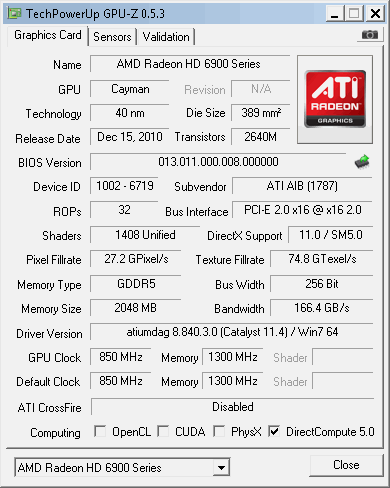
The card comes in quite small but sturdy and attractive packaging. PowerColor PSC+ HD 6950 Vortex II looks pretty nice and the hood makes the card resemble the futuristic racing car pictured on the box.
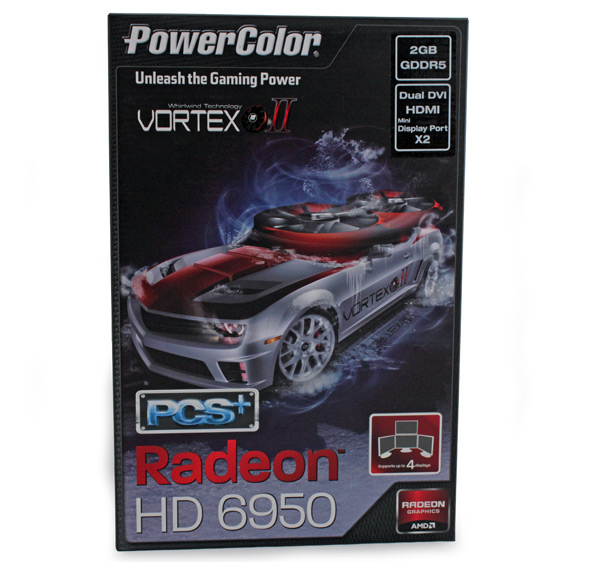
PowerColor included all the necessary accessories, such as DVI-to-VGA converter and miniDisplayPort-to-DisplayPort converter. Standard sized HDMI is already on the card.
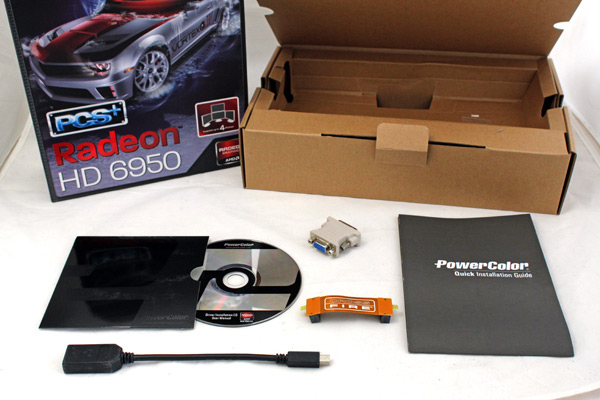
The cooler is dual slot and packs two fans. Although massive, it’s not too heavy since it’s mostly aluminum. The frame is made of plastic. It looks futuristic and it most certainly is. The fans, which normally lean on the heatsink, can be lifted off in order to get better airflow.


In the Vortex, mode the card extends into the third slot. You’ll need to adjust the fans separately and couple of handles and a light push will do the trick. The fans on PSC+ HD 6950 Vortex II can be moved even when the card is running, but make sure that it’s screwed tight to the back panel.
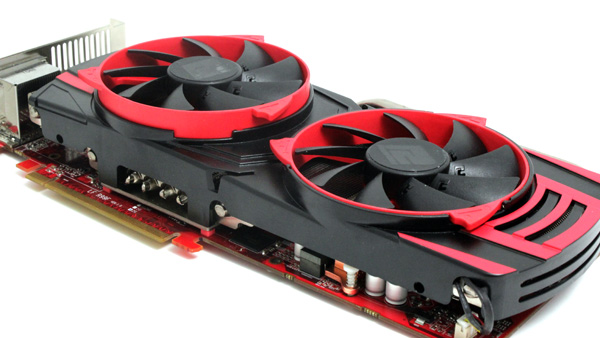
While the dual fans provide a lot of airflow, they also blow a lot of hot air inside your case. But by lifting the fan, it allows the fan to absorb the cooler air from bottom of the case, balancing ambient temperatures. You can event incline the fans slightly so the airflow is aimed at either end of the card, and as a consequence it will reduce turbulence and help heat spreading effectively from hot areas. 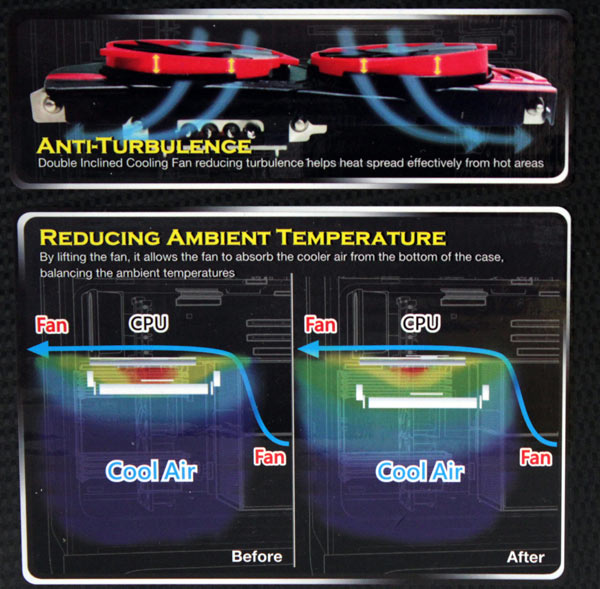
The fan is 92mm in diameter and is connected to the 3-pin connector. Fan speed regulation can be performed via the Catalyst Overdrive or any other tool you may prefer.
Power Color Radeon PSC+ HD 6950 Vortex II’s cooler has four 8mm thick heatpipes. The copper heatpipes differ in length, which also makes sure that heat is evenly distributed throughout the entire block.
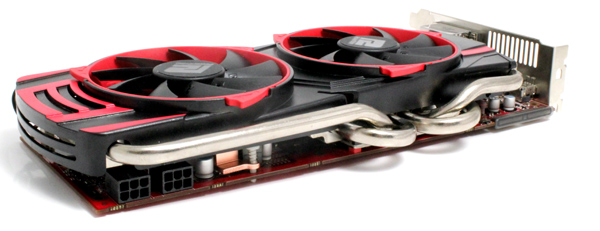
HD 6950 Vortex II card is equipped with 2048MB GDDR5 memory. The GDDR5 memory chips are made by Hynix (model number H5GQ2H24MFR-T2C). They are specified to run at 1250MHz (effective 5000MHz), but on this card the memory runs overclocked at 1300MHz. The memory chips are exposed and do not have a passive cooling solution on top of them.
The video outputs reflect the standard Radeon HD6950 design. The I/O panel features two mini-DisplayPort 1.2 connectors, HDMI 1.4a and two DVI connectors (one of them is single-link with a maximum resolution of 1920x1200). By using DisplayPort outputs it’s possible to chain up to six monitors to a single card. You can run four monitors directly from this card by using two mini-DisplayPort connectors, the HDMI connector, and one of the DVI connectors. As far as sound goes, HDMI 1.4a provides Dolby True HD, DTS-HD, AC-3, DTS and up to 7.1 channel audio with 192KHz/24bit output.
Unlike the HD 6800, HD 6900 comes with two CrossFire connectors. This means that you can use four cards in a 4-way CrossFire.
The card also features a dual-bios toggle switch that makes bios updates a breeze. Setting 1 is unprotected for user updates, while setting 2 is the protected factory default mode.
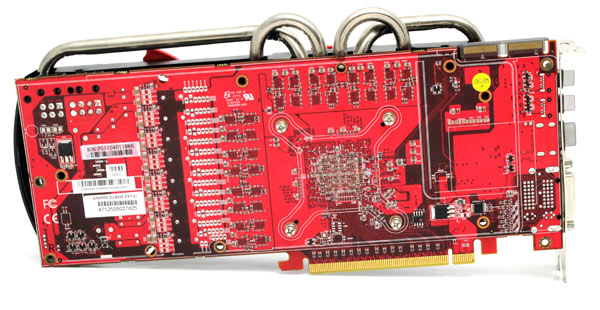
Radeon PCS+ HD 6950 Vortex II will require two 6-pin power connectors. Software GPU voltage control is possible due to use of CHiL's 8228G voltage regulator which supports voltage monitoring via the I2C communications protocol and comes with extensive monitoring and tweaking features. CHiL's 8228G voltage regulator provides the 8-phase power but only 7-phase power is used for this card.
Testbed:
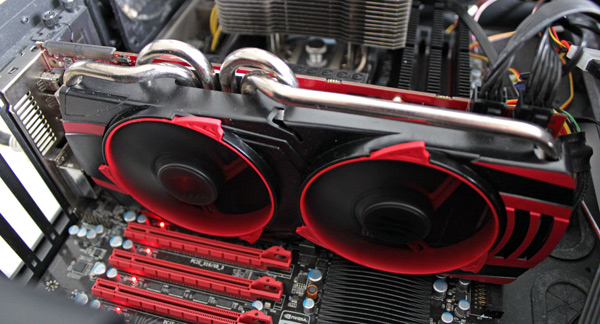
Motherboard: EVGA 4xSLI
CPU: Core i7 965 XE (Intel EIST and Vdrop enabled)
Memory: 6GB Corsair Dominator 12800 7-7-7-24
Harddisk: OCZ Vertex 2 100 GB
Power Supply: CoolerMaster Silent Pro Gold 800W
Case: CoolerMaster HAF X
Fan Controler: Kaze Master Pro 5.25"
Operating System: Win7 64-bit
Nvidia 275.20_desktop_win7_winvista_64bit
AMD 11.6 CCC
The results we got after unlocking shaders are included in the tables below. Using Techpowerup’s how-to, Winflash and PowerColor HD 6970’s BIOS (clocked at 940MHz for the GPU and 1425MHz for the memory), we managed to turn our PCS+ HD 6950 Vortex II into a PCS+ HD 6970 Vortex II (PCS+ HD 6950 Vortex II unlocked). We also included HD 6970 results (overclocked to 940MHz) to see whether unlocking and overclocking of our PCS+ HD 6950 Vortex II was successful. As you can see, it was. You can find more details on unlocking this card in the 'Overclocking' section.
3DMark 2011
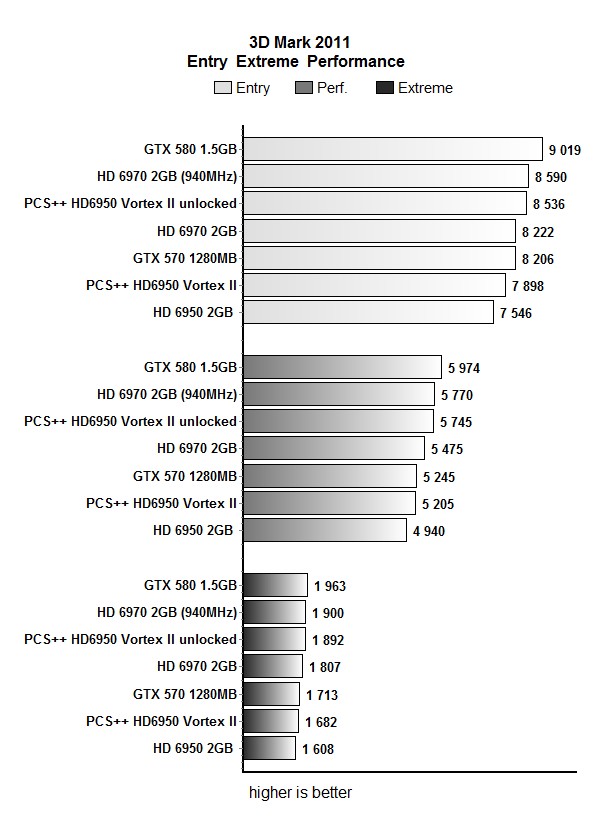
Aliens vs Predator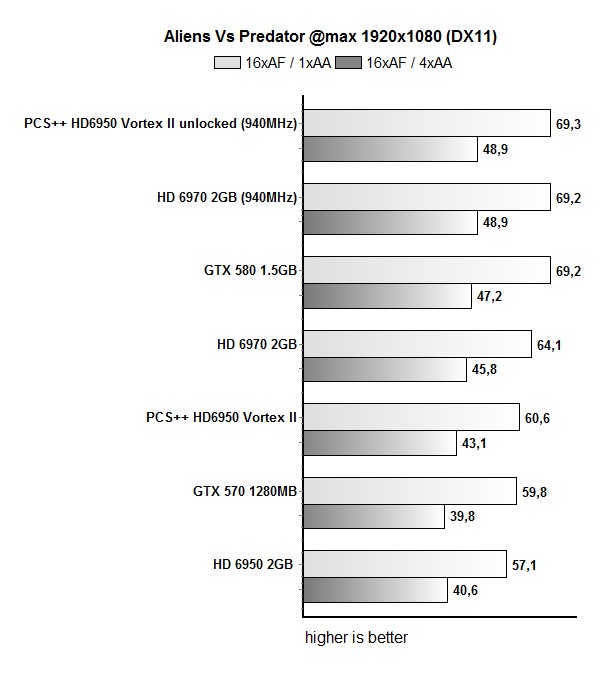
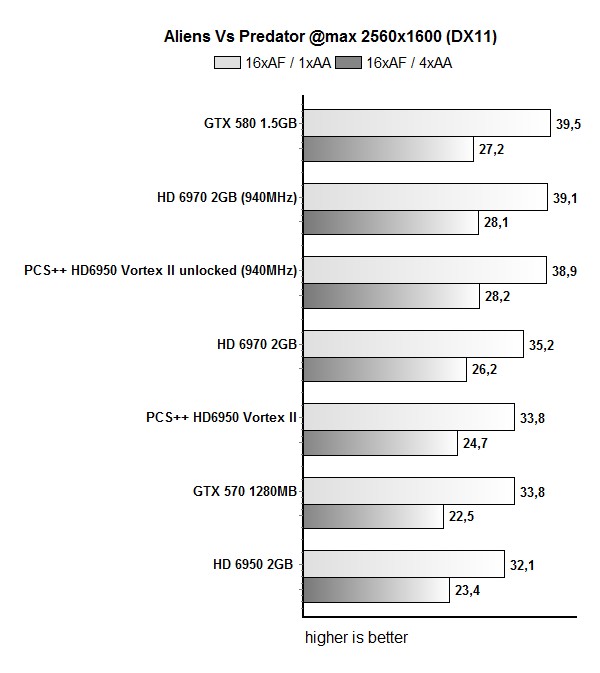
Unigine Heaven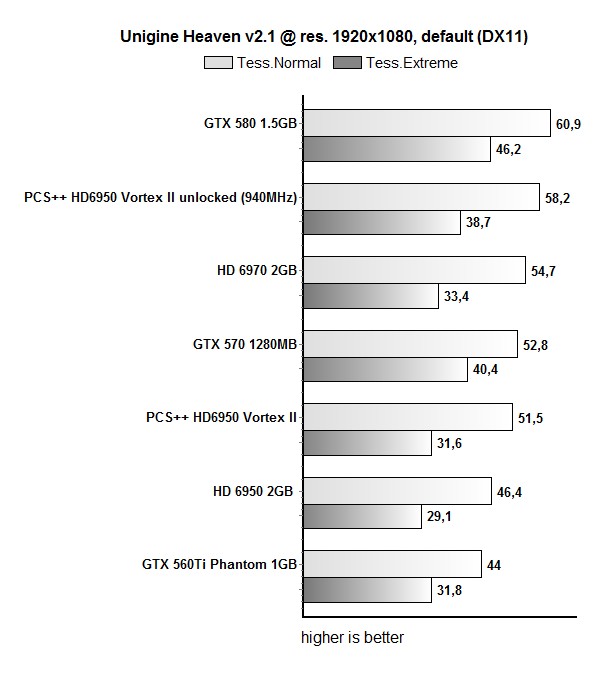
Overclocking
HD 6950’s reference clocks are 800MHz for the GPU and 11250MHz for the memory. Our today’s PowerColor card’s clocks are 850MHz for the GPU and 1300MHz for the memory.
AMD Overdrive wouldn’t allow clocks higher than 900MHz for the GPU or 1350MHz for the memory, but the same limitations apply in MSI Afterburner as well. In order to solve this, try some kind of driver uninstalling software like cleansweep, because you need to clear all driver settings before a fresh install.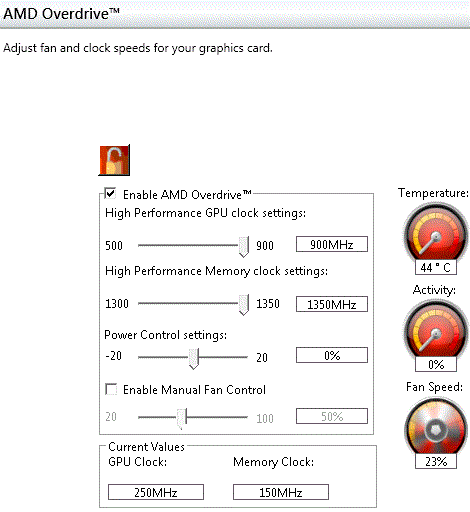
You’re aware that HD 6950 cards can activate additional shader processors within the GPU. Using Techpowerup’s how-to, Winflash and PowerColor HD 6970’s BIOS (clocked at 940MHz for the GPU and 1425MHz for the memory), we managed to turn our PCS+ HD 6950 Vortex II into a PCS+ HD 6970 Vortex II.
As soon as we restarted the computer, GPUZ confirmed we’re running 1536 shader processors and at overclocked HD 6970 clocks.
Bear in mind that not all HD 6950 will allow for unlocking. In fact, our readers have confirmed that only certain PCS+ HD 6950 Vortex II cards will support this. It is possible that PowerColor handpicked most Cypress Pro cores that can do this and is selling them as AX6950 2GBD5-P22DH ++, which comes with 1536-shader enabled BIOS pre-installed on the card and accessible via the switch.
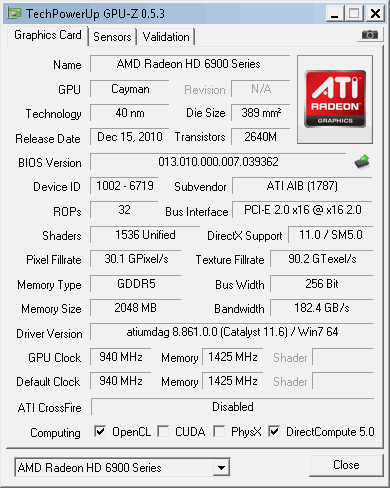
We fired up AMD Overdrive and saw that Catalyst Control Center recognizes the PCS+ HD 6950 Vortex II as a new graphics card. As you can see, the earlier limitation is gone after strapping the card with new BIOS, which suggests that the problem was in PowerColor’s BIOS.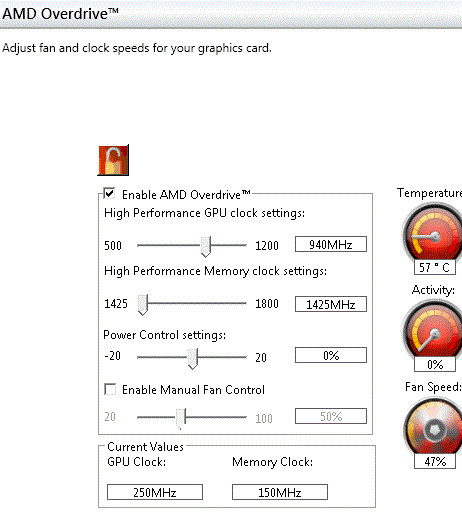
The results we got after unlocking shaders are included in the tables below. You can find Aliens vs. Predator testing results here whereas the rest is in the ‘Test Results’ section.
It’s important to note that HD 6970 cards require one 8-pin and one 6-pin connector, while the PCS+ HD 6950 Vortex II comes with two 6-pin ones. In order for the new GPU (now with 1536 shader processors) to run at its max, you’ll have to do some PowerTune tuning. In the AMD Overdrive section of the Catalyst driver, you’ll have to set the Power Control settings slider all the way to the right (+20%). This will make sure that the overclocked GPU gets more power during gaming.
The next table shows results we got when Power Control slider was in default position, as well as after allowing the GPU to draw more power. We measured about 20W higher consumption in AvP after setting the slider all the way to the right.
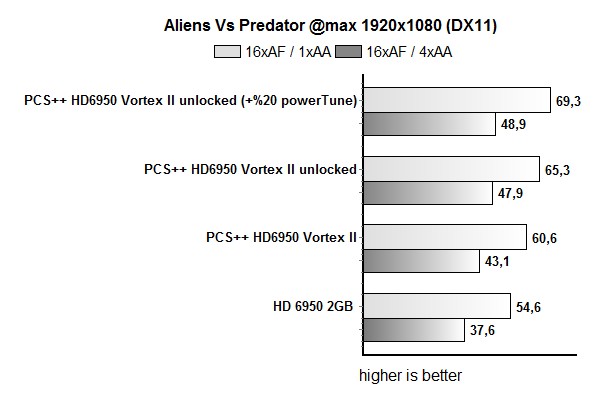

Power Consumption
We measured almost 70W higher consumption after unlocking (with the GPU at 940MHZ) and additional 20W higher in AvP after setting the power slider inside Overdrive all the way to the right.
Thermals and Noise
PowerColor PCS+ HD 6950 Vortex II’s cooling has proven it’s a quality solution that will keep the card well cooled, regardless of whether it’s in idle mode or under workload. GPU temperatures didn’t exceed 78°C during our gaming tests. The cooler was almost inaudible in idle operation (37°C). The cooler wasn’t loud, not even in intensive GPU operation.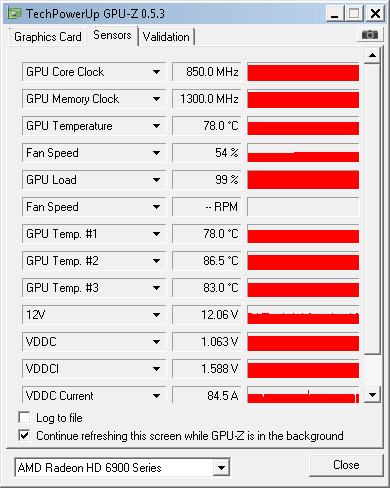
After unlocking additional shaders, the Vortex II cooler was audible enough to be called loud, but bear in mind that we are talking about an overclocked card (940MHz for GPU and 1425MHz for memory). Still the PCS+ HD 6950 Vortex II (unlocked) cooler is never as loud as the reference HD 6970's cooling.
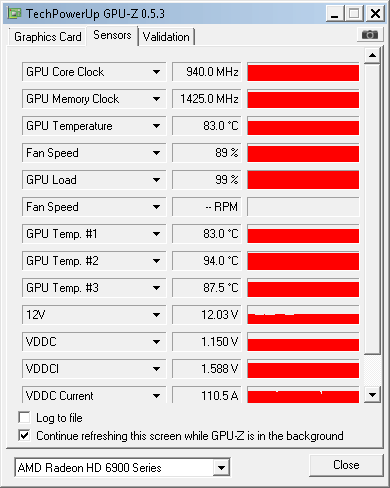
PowerColor PCS+ HD6950 2GB GDDR5 (Vortex II Edition) is a graphics card with one really efficient and stylish dual-fan cooling system.
The Vortex II cooler has two moveable fans which can be moved away from the fins, they’re quiet even during intensive gaming, and the card is factory overclocked from reference 800MHz to 850MHz which gives extra performance punch on the card.
The only downside to this dual slot cooler is that the card with two raised fans (Vortex position) will take up three slots. However, Vortex position results in only minimal cooling improvements over the default fans position (two slots) so the GPU will cooled just fine either way. The temperatures were around 78°C during gaming tasks, whereas idle mode resulted in temperatures around 37°C.
The results show about 6% performance increase compared to reference HD 6950, but you can always overclock it further because this PowerColor card has a Vortex II cooler that lets you do it.
The downside is that this card is priced at about €240, here, which is more than €40 higher than the reference version. Of course, that sort of cash can get you a reference HD 6970. On the other hand, this is an overclocked card with a specially designed silent cooler that will definitely be bragging material. Furthermore, we effectively managed to turn it into a HD 6970 with Vortex II cooling by unlocking all 1536 shaders. 



